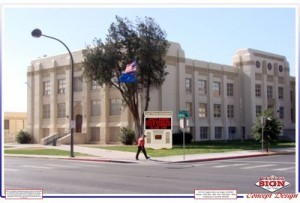It's more bad news from the Downtown Neighborhood (that is on the National Historical Register). Seems the Las Vegas Academy (the former Las Vegas High School that was built in 1931 and for almost thirty years was the only High School in town), wants to put one of those electronic marquees on the front lawn of the school at the corner of Bridger.
The magnet school, which allows students to major in performance arts, want to have an electronic marquee to advertise their upcoming productions and shows.
The Historic Preservation Commission does not believe that the front lawn and the corner of 7th and Bridger is the best place for the sign. They believe the sign will interfere with the exterior look of the campus. (See photo below to see if you agree or disagree).

Thanks to the Las Vegas Review Journal for allowing us to use this photo.
The sign was reviewed by City Planning staff. The preliminary design called for a 12-foot-high electronic marquee. It was proposed by the school at an August 13th meeting. The City Planning Staff recommended its denial to the Preservation Commission.
The Commission after reviewing the situation tabled the issue at a subsequent meeting, encouraging school staff and Nevada Sign to alter the design to better suit the character of the neighborhood.
This is the neighborhood where the homes date back to the 1920s and the 1930s. Many of the pioneering families who helped build Las Vegas from a tent city to a small, thriving community lived in these homes. Though the Neighborhood is on the National Registry, it is not protected by local preservation laws and in the past two years, many of the homes have been torn down for McOffices and McMansions.
The initial request was recommended for denial because the sign was deemed to be incompatible with the historic architecture of the school.
Planners said its size would have a negative impact on the school's facade and the contemporary technology was not appropriate within the context of the Las Vegas High School Neighborhood Historic District.
School principal Stephen Clark said whether commissioners like the sign is irrelevant. "The code says 'compatibility' and the sign we proposed we feel is quite compatible," he said.
The code to which Clark refers is the Las Vegas Municipal Code, which states that applications for alteration of historic sites can be denied if the proposed work is not compatible with the distinctive character of the overall property.
Compatibility is defined as "a pleasing visual relationship between elements of a property, building or structure."
Nevada Sign, the company commissioned by the school for the project, redesigned the template after planners said it needed to blend with the neighborhood more. Features were added to simulate the building's front entrance. A plaque was also added informing onlookers of the building's historic significance.
The school plans to take the issue to the Las Vegas City Council if the commission rejects the proposal at its next meeting. Despite commission requests to do so, Clark doesn't plan to alter the design again or change the sign's intended location.
The school wants to put the sign where White said is the best view of the Las Vegas High School Historic District's Spanish Art Deco facade.
Constructed in 1931, the building represents the growth and development of Las Vegas during the Hoover Dam construction. Before it was Las Vegas Academy, it was Las Vegas High School. The building was given historic designation in 2002.
What do you think? Let us know!! Post your comments here!